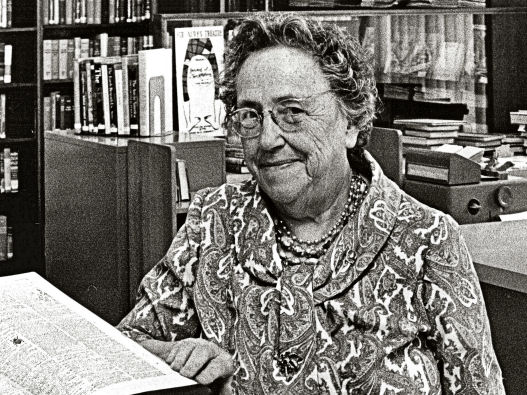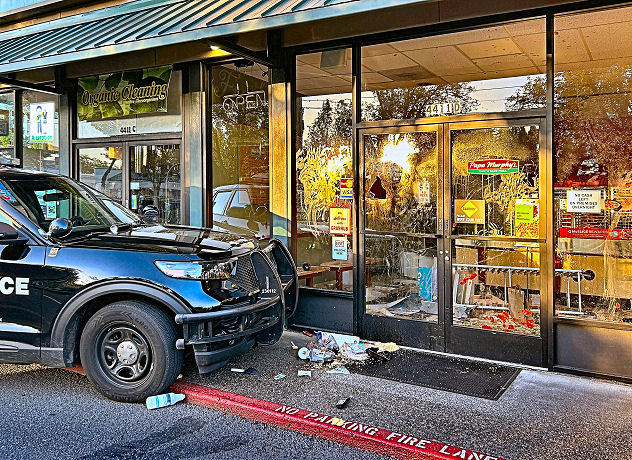SOUTHEAST HISTORY: Women who made history here!
Published 8:56 pm Saturday, May 10, 2025

- This is Dora McCormick, here shown inside Sellwood-Westmoreland’s fourth library, at S.E. Milwaukie and Lexington, in 1968. (Courtesy SMILE History Committee)
Because March was Women’s History Month, and May is Historic Preservation Month, this story celebrates some notable female residents in Southeast Portland, along with their vintage homes.
Evangeline Nyden was raised in Sellwood. Her name should be familiar to anyone who has ever read her slim book, “Old Sellwood”, which was published in 1970 by then-BEE owners Marcia and Tom Pry.
Evangeline’s father, Arnold Myers, was a building contractor in Sellwood, and the family – including her four siblings – lived successively in several houses around the neighborhood. One of them was a tall gambrel-roofed house on S.E. 13th Avenue, which now encloses the Tasi Jewelry & Gifts shop in a small storefront that was added to the front of the home. Look carefully, and you can still see the gable front of the second floor of the house rising behind the roof of the shop.
Trending
In a BEE interview, Evangeline recalled that she used to peer into the window of THE BEE, then situated on 13th Avenue in Sellwood, on her way home from school. The early owner/publisher at the time, Charles A. Thompson, invited her inside, where she was fascinated by the mechanics of printing. When she told him that she wrote stories, he encouraged her to submit one – which she did, at the age of twelve.
Until the 1960’s, THE BEE printed items of “neighborhood doings” which, along with births, marriages, and deaths, included scraps of everyday activities by its residents (and even their out-of-town visitors). These may seem trivial and amusing to us now in the 21st Century, but they documented the many connections between the “ordinary” citizens in this corner of the larger city. So Evangeline’s first offering had to do with her grandmother, and she was paid for it – at 5 cents per column inch. Two dollars a week was good money, in the early days of the past century!
But her stories then went “on pause” for many years – until her own three children were in school – and then her writing resumed, for a total of 73 years. She and her husband Edwin moved to Oak Grove, south of the City of Milwaukie, in 1945 where they operated a plant nursery on McLoughlin Boulevard; but nonetheless she returned to her Sellwood “beat” on a daily basis, contributing material well into the 1970’s after her book was published.
She moved to Corvallis, where her son Robert lived, and she died there in March of 1984. Copies of “Old Sellwood” are still available, and may be purchased at “Sundae in the Park” in early August in Sellwood Park – or after one of the SMILE History Committee’s walking tours, which are often listed in THE BEE’s “Events and Activities” calendar.
Here’s another woman of note in Southeast Portland: Dora McCormick, who was a native of Cornwall, England, originally. In 1907, at age eleven, she arrived in the U.S. with her family, who initially settled in Montana, where her father was a granite cutter. They subsequently continued west to Sellwood in 1913. She and WWI veteran Earl E. McCormick were married in 1919, and moved into a small 800-foot square-foot house on the northeast corner of 19th and Nehalem, where they lived for the next 60 years, raising six children in that tiny two-bedroom house.
Dora’s initial community activities began with her membership in the Sellwood Methodist Church. Despite her busy home life, she was also active in the Sellwood Community Club, serving as President for five years. As an early member of SMILE, Dora helped settle the Oaks Pioneer Church into its new location on Spokane Street at Grand when it was rescued, in June of 1959, from demolition in the City of Milwaukie. Later that year she served on the Pioneer Church committee with other volunteers, as the lot it was placed upon was filled and leveled, and landscaping began.
Next she volunteered to work on a committee that first met in 1962 to address the “plague of juvenile problems in the neighborhood”. Their solution was establishing the Sellwood-Moreland Youth Workshop. The Portland Fire Bureau was persuaded to rent its then-empty fire station at S.E. 13th and Tenino to the organization for a dollar a year, and volunteers gave their evenings and Saturdays to instruct boys between the ages of 13-18 in auto and radio repair, woodworking, photography, and other skills. Funds and materials were donated by businesses and individuals; and in time the Workshop became a project of the Boys & Girls Club. (Yes, that old fire station building is the structure now known as SMILE Station, and is owned by the neighborhood association.)
Dora’s final major civic project began in 1965, when the 50-year lease on the Sellwood Branch Library on Nehalem Street expired, and the building owner declined to renew it. Sellwood had launched its own public library in a storefront on Umatilla Street in 1906, subsequently adopted as the first branch of the Portland Library Association (PLA) in 1907. Consequently, the residents in the community were alarmed at the prospect of losing their library; but Dora as Chairman coordinated nine community groups as they swung into action – meeting with the PLA, finding a new location, and having a house moved to clear the chosen site at S.E. Milwaukie and Lexington (now the “Eckankar Center”).
Westmoreland architect Loyal Lang created plans for the new library, a contractor was selected, and within nine months the new library was open. It remained at that site before shifting to its fifth and current location on S.E. 13th at Bidwell Street in 2001.
Dora died in 1980 at the age of 84, but was honored posthumously by the Boys & Girls Club with a bronze plaque mounted at the base of a flagpole in front of the old Youth Workshop, which as previously noted is now SMILE Station. She was the first Northwest citizen to be presented with the “Woman and Boy” award for “giving untiringly of herself to provide training and leisure time education to youth of the neighborhood. She was someone who listened, and more importantly, cared about what you were saying”.
Our third woman of note in Southeast Portland was Catherine Boon, who at age four arrived with her family from Spokane, settling in the Buckman neighborhood. After graduating from Washington High School, she earned a degree from Oregon State College (now OSU) in 1930, at the beginning of the Great Depression, and began working as a clerk for Portland Public Schools. Three years later she married Wilbur Sohm, a home builder. When the Moreland Presbyterian Church was expanding, her husband bought two houses on what is now the church’s parking lot and had them moved onto 17th Avenue; the Sohms and their two children then lived in one of those houses for 30 years. She served on the board of FISH Emergency Services – and for Loaves and Fishes (“the Meals on Wheels People”), the PTA, and Southeast Uplift, among others.
But it was not until she retired in 1977 as Secretary at the United Way that she was persuaded by another stellar volunteer, Thelma Skelton, to attend and take notes at a SMILE meeting. Catherine went on to serve as Secretary of SMILE for eight years and President for two. As Secretary she took notes, using not a tape recorder or a laptop, but simply using her shorthand skills (check the Internet!) – subsequently transcribing them into a printed record. In a 1994 history of SMILE she recalled attending hearings and City Council meetings on behalf of the neighborhood association, offering public comments when necessary. She became interested in street lighting, served on a city street-lighting committee, and pressed for more street lights throughout the city, not just in Sellwood-Westmoreland. Her expertise and years of efforts were recognized with a plaque in front of downtown’s Portland Building.
And the last of the four notable women I want to tell you about today is Mary Hansen, who was born in Minnesota, and later married her husband Jerome H. Mallet in the State of New York. That was in 1881, and the couple afterward left for South Dakota, where Mr. Mallett operated a hardware store. When the couple arrived in Sellwood in 1907, Mr. Mallett was already 55 years of age, but he continued his craft as a tinsmith. He also built a home for himself and Mary at 8525 S.E. 11th, near Clatsop. She was already 47, but their two children were grown and she was not ready to just sit idle. She joined the Sellwood Presbyterian Church and became an active member of the Women’s Christian Temperance Union, whose goal was banning the manufacture and sale of liquor in Oregon.
That crusade was successful – voted into law in 1914, fully six years before national “Prohibition”. Mrs. Mallett became President of the Multnomah County WCTU for six years, and was State President by 1920. She also served as an unpaid officer for children in “distressed circumstances”. These experiences deepened her concern about the welfare of orphans and neglected children, leading to fundraising, and construction of the Children’s Farm Home near Corvallis in 1925.
Whatever your opinion about Prohibition, its supporters were operating in an era without any social welfare programs, and a time when alcoholism was not recognized as an addictive disease. Mary’s unflagging determination and leadership in the WCTU was vital to the startup of the Children’s Farm Home, whose success continued on after her death in 1944. Today it still functions under the auspices of Trillium Services.
Common threads link the stories of these four women: In order to create positive change, you show up, speak up, link up with others, and follow up. And never give up!
Volunteer engagement used to begin in neighborhood churches and fraternal organizations, but the city’s oldest neighborhood association, SMILE (the “Sellwood Moreland Improvement League”), has been an entry point since its organization in the 1960s. Many of its projects and programs contribute to neighborhood livability. If you live in, run a business in, or own property within, SMILE’s boundaries you are automatically a member! Its General Meeting is on the first Wednesday of every month, followed by its Board Meeting on the third Wednesday. Both take place at SMILE Station, S.E. 13th and Tenino, beginning at 7:30 p.m., and all meetings are open to everyone.
If you want to become involved, there are many SMILE committees – Land Use, History, Events, Communications, Natural Amenities, and more, that will put your time and enthusiasm to good use. As these stories of Mary, Dora, Catherine, and Evangeline (and many other citizens) will demonstrate, change starts at the grassroots level – and working with others connects residents, and builds community.
In Sellwood-Westmoreland or elsewhere – wherever you live – consider volunteering at your own neighborhood association! You really can’t tell where it might eventually lead you!




